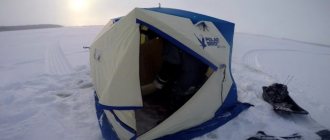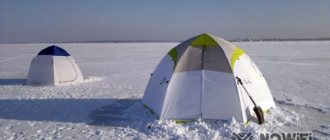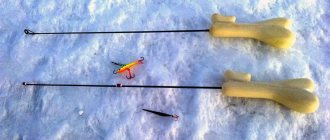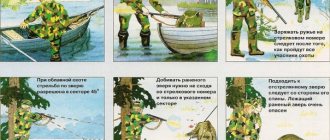Oh, this passion that forces true fishermen to sacrifice the benefits of civilization and tear themselves away from their favorite sofas! Sometimes a fishing fan forgets about everything in anticipation of a rendezvous with a pond and a fight with sparkling scaled prey. But there are things that cannot be neglected even in the heat of passion. This is your safety. Winter fishing always involves some discomfort and risks, but they can be minimized if you go to the reservoir only when the ice thickness reaches safe values.
Today the main topic of our conversation will be the rules of safe behavior during winter fishing. As they say, if you are afraid of wolves, don’t go into the forest, but only a very stupid person would go into a forest teeming with toothy predators simply in search of adventure, without first protecting himself. It’s the same with winter fishing: you shouldn’t give up true zen and adrenaline, but you definitely need to minimize the risks!
When does ice cover form?
Many fishermen begin to wait for the winter season, having just said goodbye to the summer season. Many are burdened by this expectation, counting the days in November-December until the establishment of ice cover. And they often neglect their own safety, going out onto thin ice that literally breathes under their feet.
This bait provides a rich catch even with a bad bite! More details
In this case, it is stupid to focus solely on the calendar: every year there are more and more temperature anomalies, and the indicators of the past season are not a guide. For example, in Belarus, the Smolensk and Bryansk regions there was no ice at all in the 2019-2020 season: temperatures remained close to 0°C throughout the winter. Moreover, small frosts alternated with long thaws, so there was no question of any ice fishing.
In the eastern and northern regions, a more favorable picture is observed: the ice reaches an acceptable thickness already in early December, and sometimes in November. But you also need to take into account the fact that 4-5 days of thaw with the temperature rising to positive values reduces the strength of the cover by almost a quarter!
But the ice grows quite quickly. If its thickness is less than 10 cm, the average daily increase at a temperature of -5°C is about 4 cm, and at -15°C - twice as much! But the thicker the cover, the slower it grows: it itself is a natural thermal cushion that protects the water from freezing to the bottom, and the inhabitants of the reservoir from death.
Dangerous ice areas
- Ice poses the greatest danger in late autumn and early spring. In the first case, it has not yet become strong, but in the second it begins to melt;
- You should not move on ice covered with a large amount of snow, since it is unrealistic to understand the thickness under the snow layer;
- Ice holes and fishing holes are dangerous; if you don’t notice them, you can fall through the ice;
- The ice on the shore is much thicker than in the middle of the reservoir;
- In swamps, the ice is usually thin, it is heated by gases that are found in the swamps;
- When temperatures rise, you should not go fishing, the ice becomes friable and brittle, turning from translucent blue to white.
Safe thickness indicators
Any experienced winter traveler will say: the most productive fishing is on first ice. At this time, even a novice jig fisher can catch a lot of peaceful fish that have not yet gone to wintering pits. And what kind of pike they catch during this period! There’s nothing to say about perch – they take on anything and everything. However, no catch is worth the life and health of a person, so winter fishing enthusiasts are strongly advised not to go out on the ice until its thickness reaches the conditionally safe 7 cm. However, only 10 cm of cover will provide guaranteed safety, and only if basic precautions are taken.
The above indicators are only relevant for winter fishing in fresh water. Let's look at other criteria:
- Traveling on skis - from 8 cm. Skis are the optimal means of transportation across large frozen water areas covered with snow (you can’t really walk on bare ice on them). They not only speed up movement, but also help distribute a person’s mass over a larger area (not feet, but skis).
- Snowmobiles - from 12-15 cm. A wonderful means of transportation, especially useful for search fishermen who are constantly moving around a body of water.
- Salt water - from 15 cm. Ice made from sea water (or with its admixture) should be thicker: it is a priori less durable.
- Children's activities - from 12 cm. In this case, we mainly mean ice skating and sledding.
- Organized movement of pedestrians - 15 cm. It is officially allowed to move from shore to shore where the ice thickness reaches the specified value. Otherwise (outside places of organized movement) you go at your own peril and risk, and no one is responsible for safety.
- Movement on cars – 30 cm. This value is relevant for organized car crossings on ice, marked accordingly.
How to behave on ice
Correct behavior on ice
First of all, you need to make sure that the weather outside is suitable. Suitable for ice fishing. You should not go out on the ice in bad weather: snow, rain, fog, as well as night time - this is a reason to abandon the planned fishing.
It is equally important to choose the right place to descend onto the ice. It should be a comfortable, flat place
Otherwise, there is a risk of slipping and falling on the ice, breaking it.
Avoid dangerous areas and areas where the ice is potentially thinner. About. Where such places are located was discussed above. Also, you should not gather in one place with a large group and drill holes too close to each other. Perforated ice holds worse than solid ice.
But it is better to move on ice along established paths. If one person has passed here, then the ice will most likely support the next one. If there is no path, then you need to make your own path. Pre-checking suspicious areas with a stick. If you are not sure about the reliability of the ice in a certain place, it is better to walk around the area. Also avoid old fishing spots, holes and ice holes.
Read How to tie two hooks to a fishing rod
It is important to remember that a person with a large weight, and fishing equipment weighs a lot, is exposed to additional danger. Before going out on the ice, you should loosen the straps of your backpack so that if something happens you can quickly throw it off
You can buy new equipment, but there’s simply nowhere to get new life.
If, while moving on ice, you hear a crash or see water on top of the ice, it is better to immediately leave the dangerous place and return to the shore. This should be done slowly, without sudden movements. It’s best to just lie down on the ice, spread your arms and legs wide apart, and crawl around.
Determination of ice strength
All of the above is good in theory, but in practice it is difficult to measure the thickness of the cover. It is best to wait for the corresponding message in the fishing bulletins relevant to your region. In any case, at least a week must pass from the moment stable frosty weather sets in.
Next you should evaluate:
- Cover color . The strongest and safest is blue and greenish ice. White and grayish covers are not so durable, especially if combined with a loose spongy structure and all kinds of inclusions (sand, pebbles, algae, and so on).
- Presence of water on the surface . If there is water on the surface, you shouldn’t even go out onto it: the risks are colossal.
- Silence of movement . If you step on the ice, and after a while you hear a characteristic crack, immediately carefully turn back.
An angler can objectively assess the thickness of the ice only when drilling a hole (a tape measure or ruler will help), but for this manipulation one must move far enough away from the shore, which is not always safe. Particularly avoid areas:
- Covered with snow . Any danger can be hidden under a snowdrift, so if possible (not the entire reservoir is covered with snow), it is better to bypass such an area.
- With a strong current and springs . In such places there may be potholes that are invisible from above.
- Wetlands . Swamp gases create a kind of greenhouse effect: even in severe frosts, the ice is considerably heated from below, which does not contribute to its strength.
- At the mouths and confluences of rivers . There is a current that is heterogeneous in speed and direction.
- Wastewater discharge . Such areas should definitely be avoided: wastewater is always warm, and is not particularly clean.
The abundance of fishermen on a small area of ice, on the one hand, indicates its promise and relative safety, on the other hand, the risks increase: you can fall into a hole slightly covered with ice and covered with snow. At best, get your foot wet, but in the cold this is not much joy.
Last Ice
This period in the evolution of ice begins when in spring the average daily air temperature becomes close to 0°, that is, snow begins to melt and meltwater appears. At first, the ice becomes dangerous near the coast, where the snow melts faster than on the ice. Streams of melt water, flowing into the reservoir, wash away the edge of the ice, and the heat emanating from the heated ground further contributes to the process of destruction of the ice edge.
The apparent strength of coastal ice after the morning frost is deceptive - with solar heating, it may not allow anglers to return, so access to the shore must be prepared in advance by taking long poles or boards onto the ice. It is advisable that the exit be in shallow water, and it is better on the side where the ice in the afternoon will be in the shadow of a forest or high bank. Some more time will pass, and wide open waters will form near the shore, the cause of which will be the destruction of fast ice and the increase in water in the reservoir. Although the main ice will still remain quite reliable, it is unwise to get out on it without a boat.
The main body of ice is being destroyed in stages: when the average daily air temperature exceeds the positive mark, snow on the surface of the ice cover will begin to melt intensively, and this process will be accelerated by winds, damp fogs and rains. Surface water is absorbed into the ice, disrupting its monolithic structure, causing the ice to disintegrate into individual, vertically standing crystals (a needle-like structure), and the connection between these elements gradually weakens. At the same time, the ice melts from below
For these reasons, spring ice is treacherous: having lost the elastic properties of a monolith, it will not crackle in warning, as in the first ice, but with a telltale hissing sound it will suddenly disintegrate under the feet of a careless fisherman
Ice is especially dangerous where there has been water under the snow all winter - these puddles are visible on the last, snow-free ice, and such places should be avoided. It is better to move along the last ice along old winter paths (they stand out on its surface) and fish in “familiar” places - here the ice is thicker and freezes better over the winter.
Under no circumstances should you gather in large groups, in heaps, “chopping off” your lucky brother - collective baths, as a rule, end tragically.
You need to save someone who has fallen on the spring ice intelligently, in no case coming close to the formed lane: you should crawl towards it, pushing a long pole or board in front of you, or throw the end of a thick rope with a wide loop to the drowning person from a safe distance, which he will throw over myself. However, everything depends on the state of the “swimming”; having frozen, he can fall into a state of shock, but still stay afloat. Then you need to act extremely quickly, and you can’t do it without an inflatable boat.
Read Haddock fish - benefits and harm
A physically strong person who finds himself in an unpleasant situation will be helped by special “rescues” - devices that look like a thick awl and hang on cords on fishing clothes. By sticking them into the edge of the ice, you can pull yourself up and get out of the water. However, these good means of rescue are of little use on too loose spring ice and on young thin ice.
To prevent trouble from happening, you must always soberly assess when it is better to leave ice fishing until the next season and move on to fishing on small rivers.
On rivers that are still bound by an ice shell, you should not go out on the ice when there is a noticeable increase in water, and it is better to continue fishing on stagnant bodies of water, moreover, large ones that slowly respond to rising levels. Here, the signal for the final departure to the shore will be the arrival of lapwings and gulls, and sometimes wagtails.
People say: “The wagtail breaks the ice with its tail.” After the arrival of this nimble bird, busily running across the ice and collecting the first spring insects, we can say with confidence that no more than a week remains before the ice disintegrates.
I would like to believe that readers will not consider this article just a warning that ice can be dangerous at all stages of its formation. I hope that she added to their knowledge about this wonderful phenomenon and helped the ice platform become a reliable friend for all those who are passionate about fishing.
A. Mailkov “Fisherman - Elite No. 06 - 1999”
Rules for safe behavior
Let's assume that theoretically the ice thickness has reached the minimum permissible values, and you go on your first fishing trip of the season. In this case you should:
- Move at a calm pace. Do not run or jump under any circumstances, and do not try to test the strength of the cover with your foot. It is best to walk at a measured pace, practically without lifting your feet from the surface (like skiing).
- Check the path with an ice pick. This primitive device, like a crowbar on a stick, is necessary for any fisherman: it can not only tap the ice to choose a safe path, but also clear the holes from ice. As a last resort, use at least a long, strong stick.
- Avoid potentially hazardous areas. We talked about this above: everything that differs from the general picture should be considered an anomaly by default.
- Walk along the path. If footprints are visible in the snow or a path has been trodden, this indirectly indicates the safety of movement and sufficient thickness of the ice.
- Carry a load on one shoulder. Position the fishing box or backpack so that you can instantly discard the ammunition and free up your other hand. Ideally, if the ice is very suspicious, it is better to drag the load along with you on a rope.
- Go in a dispersed group. Under no circumstances should you walk alongside a large group, especially in step: the resonance effect and increased load can destroy even a visually strong cover. The optimal interval is 5 meters or more.
- Provide yourself with basic means of salvation. This can be a rope up to 20 meters long (with a loop and a weight at the end), the same stick, and so on. The rope should be in an easily accessible place or hanging around your neck!
Recommendations for winter fishing
Recommendations for winter fishing enthusiasts: never fish in crowds, try to spread out evenly throughout the pond. There are separate rules for fishermen, neglect of which is fraught with serious consequences. We list the most basic safety rules for fishermen:
- Never go out on ice that causes you doubts; if you find yourself on such ice, try without lifting your feet and slowly slide along the ice to a safe area.
- The strongest ice is transparent, which is 5 cm long; walking on white ice is only possible if it is 10 cm thick.
- Near reeds and reeds, the ice is not strong and is dangerous.
- Be careful when the ice is covered with a layer of snow.
- Ice forms differently in each part of the reservoir, at depth - last of all, we can conclude that the ice there is not strong.
- In places where springs flow, the ice is very weak.
- It is not recommended to walk on the first ice alone, preferably with partners. In this case, it is mandatory to maintain a safe distance of at least 3 meters.
- Before going out on the ice, take an ice pick with you. This way, you can “grope” the ice and only after that, stand on it. If the ice breaks through after an impact, walking on it is prohibited.
- Fishing gear must be carried in such a way that in case of failure, it can be easily disposed of.
- If you need to cross a dangerous place at any cost, you need to tie yourself with a long rope, the end of which will be next to your comrade.
- Stay away from places where fishing nets are placed - you can easily fall into a hole.
- If you are not sure about the strength and thickness of the ice, do not drive on it!
You should be extremely careful and concentrated while moving on ice, remember this!
In addition to weak ice, other dangers await anglers. Many funny things happen on slippery ice. After a person slips and falls on the surface of the ice, serious consequences “pop up”. You can break limbs, sprain ligaments, hurt your back, or get a concussion. If you get a bruise, you need to apply a cold compress (a piece of ice, a wet towel, any cold object that is at hand). But you can only take a warm shower or bath after a couple of days. If a person has suffered a tendon sprain, it is worth doing the same procedures as for a bruise. How can you tell if you have a sprain? – at the site of damage, swelling and pain will certainly occur.
Read Tungsten jig for winter fishing
If your arm is injured, you need to tie it up with improvised means; if your lower limb is damaged, you can transport the victim on a sled. In addition to sprains, you can receive an equally dangerous injury - a concussion. How to determine that a concussion has occurred? – darkening of the eyes, dizziness, loss of consciousness, slow pulse, and vomiting.
Regardless of the severity of the concussion, the victim must remain in bed. Treatment should only occur under the supervision of a physician.
In addition to the above dangers, the angler is exposed to low temperatures. As a rule, the limbs of the hands and feet, as well as the nose and ears, are the first to suffer. If a person is on ice for a long time, at low temperatures, hypothermia and frostbite cannot be avoided. Therefore, before you go winter fishing, you need to put on warm clothes. Drinking alcohol in the cold is prohibited! To keep warm, take a thermos with tea with you.
Actions in case of contact with water
If you do fall into the water, the main thing is not to panic: chaotic body movements will only aggravate an already unenviable situation. So:
- try to come to your senses and do not let your head fall into the water;
- call for help louder and without additional phrases;
- if you can do it easily, take off your backpack and shoes;
- do not cling to the edges with your fingers: the ice will crumble, only increasing the area of the hole;
- try to increase the area of support on the thickness of the ice: spread your arms, put a stick and lean on it, gradually crawling onto the ice with your chest;
- make ordered movements with your feet as when swimming crawl: the main goal is to give your body a horizontal position and push yourself onto the ice;
- Having got out, roll away from the hole, crawl a little on all fours, then carefully stand on your feet;
- immediately (but do not run on the ice!) go to a warm place, call a doctor and drink hot tea. Alcohol in this situation will only worsen the situation.
How to save a drowning person
When you hear a cry for help, you should not rush headlong to the victim: you risk ending up in the water next to him. You need to do the following:
- Throw a rope or stick to the victim. You should approach the hole as carefully as possible, and no more than the length of a rope or stick - it’s safer. If the ice is thick enough, you can simply walk carefully, but it is better not to trust visual impressions and crawl to the spot.
- If there is no rope, you need to spread out on the ice as much as possible and crawl to the edge. You'll have to use your hands exclusively. It is better to give the victim some kind of flat support to distribute the load, such as a ski, a piece of plywood or plastic. You can pull it out either by the hand or by the collar.
- The victim must be pulled out using uniform forward movements. In this case, you need to remember the need to distribute the load, that is, do it lying down or sitting.
- When you pull the victim out of the hole, help him crawl away from the dangerous area. Let him not rush to get back on his feet right away.
- Ensure that the victim is moved to a warm place and receives medical attention - frostbite may be missed without a doctor's examination.
What should be the minimum cover thickness?
In most regions of our country, fishermen go out on the ice if the thickness of the ice on the reservoir exceeds 7 centimeters, while the safest is ice whose thickness exceeds 10 centimeters.
Crossing the pond on foot can be permitted if the ice thickness exceeds 15 centimeters.
Authorized transportation of vehicles on ice becomes available only if the thickness exceeds 30 centimeters.
It is worth remembering that the ice is not equally thick in all places. Even when the optimal thickness is reached, thin areas that pose a danger are observed in the central part of the reservoir, near the shore, as well as in the area of the confluence of rivers.
Angling tips
Even if you do not yet consider yourself a true fan of winter fishing, listen to the recommendations below - maybe one day they will save your life:
- Buy rescue gear. This simple device is also called “ice awls.” It is a cord equipped with strong awls on the handles. By sticking these teeth into the ice and pulling yourself up on them, you can get out of the water as quickly and reliably as possible. When fishing or any movement on a frozen body of water, life preservers should be worn exclusively around the neck (not in a box or backpack).
- Keep in mind that the ice thickness near the shore is usually greater. In theory, for measurements it would be possible to drill a hole a couple of meters from the shore without exposing yourself to much risk. However, these measurements, unfortunately, will not be correct.
- Don't forget about spring risks. With persistent spring thaws, the reservoir becomes no less dangerous. Don’t be tempted by the famous pre-spawning rush to the point of losing your vigilance: the ice has become covered with water, changed color, become porous and crackled – ice drift is imminent. Well, an adult can guess about the dangers of ice skating himself.
- If anything, crawl! If you hear a characteristic crack or determine by other signs that the ice is extremely unreliable, turn around and slowly walk towards the shore. Better yet, crawl - this is practically guaranteed safety.
- Do not drill holes next to each other. A large number of holes drilled at a short distance from each other significantly reduces the strength characteristics of the ice. Therefore, maintain an interval of at least 2-3 meters and do not be close to other anglers.
Winter fishing is true male zen, steeped in adrenaline. However, remember that any risk must be justified and minimized!
Fishermen wonder why I’m biting and they’re not?
I’m revealing a secret just for you: it’s all about the miracle bait! More details
Safe Ice Thickness for Fishing
With the onset of freeze-up, predatory and peaceful fish species continue to actively feed in anticipation of the deep winter. When fishing on the first ice, you can count on a good catch of pike, bream, roach, perch and many other active fish
But before going out onto a winter pond, it is important to know what safe ice thickness allows you to move freely on the ice surface, and what unpleasant surprises can ruin your fishing. Please note that the thickness of ice on the river may vary in different places.
Ice safety indicators
If the weight of the fisherman with equipment does not exceed 100 kg, then you can go to reservoirs with standing water when the ice thickness increases above 7 cm. When planning fishing on the river, you need to wait for the period when the ice thickness at the fishing site exceeds 10 cm.
On large bodies of water, vehicles are often used. In this case, the following indicators must be taken into account:
• Ice thicker than 12 cm allows safe movement on a snowmobile;
• The use of a passenger car is permissible if the ice thickness is at least 30 cm.
Uniform ice thickness occurs only on small stagnant lakes and ponds, free of vegetation sticking out on the surface. On large and small rivers, ice grows unevenly. On rivers, solid ice gradually drops to 0 as it approaches an unfrozen rapid or a channel current free of freeze-up. It is dangerous to approach the edge of open water. When moving across the ice cover, you should constantly monitor its thickness.
Areas and places where the likelihood of failure increases:
• In the coastal zone;
• Near the edge of open water;
• In reed thickets;
• At the confluence of tributaries;
• Near vegetation or other obstacles sticking out on the ice surface;
• In wetlands;
• In areas with underwater springs and in places where wastewater flows;
• Above the channel flow.
In addition, it is important to take into account that the strength of the first ice differs from the strength of the last ice. If the dangerous first ice can crunch and bend, then the last ice often fails immediately
This is due to the fact that as the temperature rises, the crystals that make up the ice become brittle, and the danger of loose ice falling through under a moving fisherman increases.
How to determine ice thickness
It is important to understand the question of how to determine the thickness of ice. When determining ice thickness, it should be taken into account that after thaws the snow cover freezes after melting
It cannot be added to the thickness of the freeze-up.
When doubts arise about the strength of the first or last ice, as well as during periods of prolonged thaws, then it is necessary to include an ice pick or a regular stick in your winter equipment. Checking the thickness with a fishing ice drill is not advisable. Testing strength by kicking is unacceptable.
Before going out onto a frozen body of water, you need to pay attention to the color of the ice cover. Blue or green shades indicate reliability
Yellowness and matte color are characteristic of fragile and therefore unreliable ice.
You must enter the ice in the coastal zone without raising your feet. If a hole appears from one blow with an ice pick, then it is better to give up fishing that day. When using a stick, the fragility of the stick is indicated by the appearance of cracks at the point of impact.
If there are no negative signs, then you should drill a hole and check the thickness by hand or using a metal ruler, at the end of which a perpendicular bend is made. Measuring the thickness of the ice cover on the river must be carried out after each movement.
So, safety measures during winter fishing play a vital role. And only when the nuances of determining the safe ice thickness are taken into account as much as possible, then you can enjoy exciting fishing on the first and last ice.











